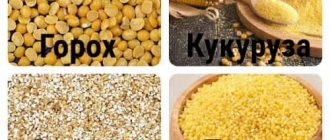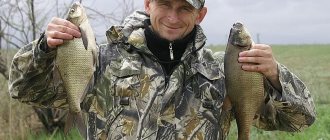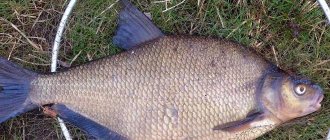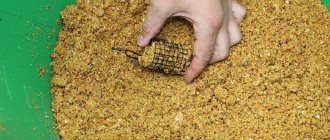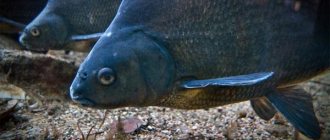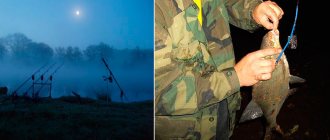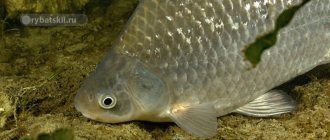Buy quality products at affordable prices in the best fishing online stores
. Give gifts to yourself and your loved ones!
we are in social networks
— subscribe to us on Facebook, Youtube, VKontakte and Instagram. Stay up to date with the latest site news.
The most productive period for fishing bream is considered to be summer and several spring and autumn months. At this time, the water is heated to its maximum and the fish’s digestive processes proceed much faster. Bait for bream when fishing on a feeder should consist of high-calorie elements: store-bought powder, biscuits, peas, corn, maggots and bloodworms. Liquid aromas with vanilla, anise, fruit and other sweet aromas are often added to mixtures.
Bream loves to eat, so the angler’s task is to create a feeding spot that will keep it in one place for a long time. Large bream will not be content with crackers or dust particles. Or rather, such a dubious pleasure for them will last 10-20 minutes. If there is no larger, high-calorie food at the bottom, the bream will not stay at the point for long.
Recipe for bait for bream using feeder No. 1
This recipe is suitable for medium to fast flowing waters. The basic components of the bait are boiled millet or peas. For preparation we will need:
- Boiled peas – 1 kg
- Boiled millet – 1 kg
- Breadcrumbs – 1 kg
- Store-bought bait (bream) – 2 kg
- Liquid aromatics (molasses) – 300 ml
- Maggot – 4 servings
- Chopped worm – 1 serving
- Clay or soil (if we fish in a strong current) – 1 kg
A few words on cooking peas. We cook it as usual - so that the water completely boils away. Add 3 cups of water to 1 cup of peas and cook over medium and low heat, stirring occasionally. It is better to cook in a metal or aluminum pan so that the porridge does not burn. It's even better to cook in a pot.
After cooking, wrap the pan with a towel and leave the bait to simmer for an hour or two. After this, we remove the peas and grind them in a meat grinder, but not all of them, so that we get such a loose and homogeneous mass, somewhat reminiscent of flakes. We will add the second part of the peas, not ground, to the feeders in small portions, the so-called plugs.
Cook the millet for 10 minutes until the grains open. For one glass of cereal you will need 3 glasses of water. We wait until the water has completely gone and we get something like this:
As a result, we will get very crumbly millet, which will be easily washed out of the feeder:
Let the millet brew for 30 minutes and mix it with ground peas. When fishing, we first add store-bought bait and crackers. Before this, we pass them through a medium sieve. Then add clay and mix everything well. After this, add half the maggot and the entire portion of the chopped worm and pour in the molasses. Mix everything and put one part in a container and put it in the shade, and pour the second part into a bait bucket:
Feeder fishing for bream involves abundant starting feeding using a volumetric feeder of this type:
After starting feeding, we use a regular feeder. We stuff maggots and some peas into it using stoppers.
Nuances of bait for the feeder
Feeder bait has a number of nuances. The composition of the bait will vary depending on the type of reservoir, its current, and the type of fish living there. The feeder itself also plays an important role. Regardless of the characteristics of the reservoirs, there are basics that you need to know.
The bait must be constantly thrown into the same place that you have chosen. If you see that you have cast the feeder far from this place, it is better to stop casting.
It is important to produce bait in the same place; if this is not taken into account, the fish will be scattered between two areas.
This oversight can reduce the quality of the catch. If, nevertheless, the feeder with bait is immersed in the water, distribute the bait over the water surface with intermittent movements. This will not greatly undermine the previous efforts.
Recipe No. 2
To prepare this recipe we need the following ingredients:
- Millet – 1 kg
- Rusks - 1 kg
- Ground roasted seeds – 500 grams
- Black bread – 500 grams
- White bread – 500 grams
- Vanillin packet
- Chopped worm – 1 serving
First, prepare the millet as in recipe No. 1. Next, take the bread and cut it into small pieces. Next, take the seeds and grind them with a manual or electric meat grinder along with the bread. We should have a fragrant mass:
We put millet, vanilla, and crackers into the bait, and we get bait that is suitable for fishing on the current with a feeder. At the pond, add pinches of chopped worms to the feeders. This bait is enough for one standard feeder session using 1-2 fishing rods.
Loosening elements
- Breadcrumbs;
- Fried flour;
- Ground biscuits;
- Bran;
- Corn.
The resulting bait must be passed through a large sieve, this is necessary to saturate it with oxygen. Oxygen remains in the bait; during the process of forming it into a feeder, it also remains in it. After immersion in water, it is forced to the surface, thereby accelerating the process of decomposition of the bait.
To speed up the digestion process, beets and peanuts are added to the bait. Thus, the fish quickly digests food and is in constant hunger. For greater attractiveness, chopped worms are added to the bait.
Recipe No. 3
To prepare bait according to this recipe we will need the following ingredients:
- Boiled peas – 1 kg
- Boiled millet – 1 kg
- Cake – 500 g
- White breadcrumbs – 500 g
- Fish food – 400 g
- Hercules – 500 g
- Salt – 1 teaspoon
- Granulated sugar – 5 tablespoons
- Ground coriander – 1 teaspoon
- Cinnamon – 1 tbsp. spoon
We cook pea and millet cereals in the same way as in previous recipes and pass them together through a meat grinder. After this, add crackers and flour. Pour boiling water over the Hercules and leave to simmer for a few minutes. Then drain the water and add rolled oats to our bait.
After this, add flavorings and preservatives in the specified quantities. First, mix these components well in one bowl and add them to the bait.
When fishing, add water or chocolate-flavored molasses. Bream loves sweet smells, especially the smell of chocolate. Therefore, during fishing, you can gradually add molasses to the bait or dip it with chocolate spray. Homemade aromas based on fruit syrups performed well. They are mixed with water and added to complementary foods instead of molasses or dips. Again, chocolate, vanilla, raspberry, strawberry and melon syrups are suitable for bream.
This bait is designed for one 5-6 hour fishing trip using 1-2 fishing rods. Moreover, this implies constant feeding of the point every 5 minutes.
Recipe No. 4
Another successful recipe for catching bream consists of the following ingredients:
- Steamed rolled oats, ground in a meat grinder – 1 kg
- Breadcrumbs – 2 kg
- Finely ground macadamia – 1 kg
- Ground hemp seeds – 30 g
- Ground coriander – 100 grams
- Canned corn – 2 jars
- Cocoa powder – 4 spoons
- Vanillin packet – 1 sachet
- Coconut flakes – 100 grams
Mix all components in one container. We add corn directly on the shore. We should get both crumbly and high-calorie bait. Corn grains will attract bream to the fishing point. They will highlight the feeding spot and make it more noticeable. To further highlight the bait, many feeders add pastoncino to its composition. These bright pieces “color” the bait.
Recipe No. 5
To prepare bait for this recipe we will need the following ingredients:
- Store-bought bream mixture – 1 kg
- Ground peanuts – 500 grams
- Canned corn – 400 grams
- Breadcrumbs – 1 kg
- Biscuit cookies – 1 kg
- Molasses – 0.5 l
We mix all the ingredients on the shore in a large container. Be sure to pass the bulk components through a medium sieve. We grind the cookies at home in a meat grinder. We use sweet, dark molasses. We fill it in several approaches. First, fill in half and mix the bait. Then after 10-15 minutes add the second part. As a result, we should get the following bait:
When fishing, if necessary, you can moisten it or, conversely, add granules, making it more crumbly.
How to rationally prepare bait?
If our bait consists of a large number of dry ingredients, then the best option would be to prepare 10-15 kg of dry bait in the store-bought manner and package it in 2 kg bags. The only component that should not be added is breadcrumbs. The fact is that over time they lose their freshness and aroma. It is better to buy crackers fresh or make your own.
Rusks are obtained from the remaining pieces of bread. They are dried in the microwave and passed through a meat grinder. It is best to store them in five-liter plastic bottles in a cool place.
We cook porridge for every fishing trip. The only option is to cook 10 kg of cereals and place them in the refrigerator. If your refrigerator has a spacious freezer, then use this option. When you go fishing, you take several kilograms of dry and liquid bait and add aromas, worms and maggots to it.
Feeder feeding
Translated, the word feeder means to feed. That is, bait and feeder are integral. From 5 to 15 feeders are installed in the selected area of the reservoir; first you need to check how the food behaves in the water. Place the feeder on the shore and see how the bait behaves.
- The bait must have a certain consistency; it should not disintegrate immediately when it gets into the water.
- When throwing the feeder, it is important that the feed does not scatter in the air.
- It must pass through the water layer and only then should it begin to disintegrate and saturate the bottom with bait.
- After immersing the feeder in water, you need to wait a few minutes.
- And only then, after the bait gets wet, use intermittent shaking movements to fill the water with bait.
- These movements must be repeated about 15 times.
At a short distance, you should not install more than five feeders if your target is white fish. It is important not to overfeed the fish during the cold season.
For large fish, crucian carp or bream, more bait is needed, up to 15 feeders.
You can feed the fish with different size feeders. It is important to know that feeders of different sizes behave differently in the water column, and they may be carried away from the place in which you originally installed them. It will be almost impossible to reinstall it there.



